Betta fish come in a wide variety of breeds that are named in creative ways, such as Dragon Scale, Butterfly, and Half Moon. Over the years, breeders have carefully selected and bred Betta fish for specific physical characteristics like flamboyant tails and elegant fins. They can have iridescent scales or marbled colors, making each one unique and stunning.
Despite some Betta breeds being common and considered dull, others are rare and prized on the Betta show circuit. Their behavior can also vary, with some breeds being more aggressive while others are calmer. Additionally, some breeds make better tank mates with certain fish types than others.
To simplify the process, we’ve categorized our guide by tail type, color, and fin type. Whether you’re a novice or an experienced fish keeper, our beginner’s guide offers a comprehensive overview of the many breeds of Betta fish.
Betta Fish Types Based on Tail Type
Let’s start by exploring Betta fish types based on their tail type, which is often their most distinctive feature.
1. Veiltail (VT)

If you’re looking at Betta fish in a pet store, chances are, you’re seeing Veiltail Bettas. This is the most common tail type found in a commercial setting. Though once popular, overbreeding and an asymmetric appearance have led to them falling out of favor on the show circuit. However, they still have attractive long, flowing tails that droop from the caudal peduncle and long anal and dorsal fins.
While connoisseurs may consider them inferior, Veiltail Bettas are a beautiful and calm breed, making them great for beginners. It’s important to give them a reduced current in the tank, as their droopy tails make them weak swimmers.
2. Delta Tail (DT)
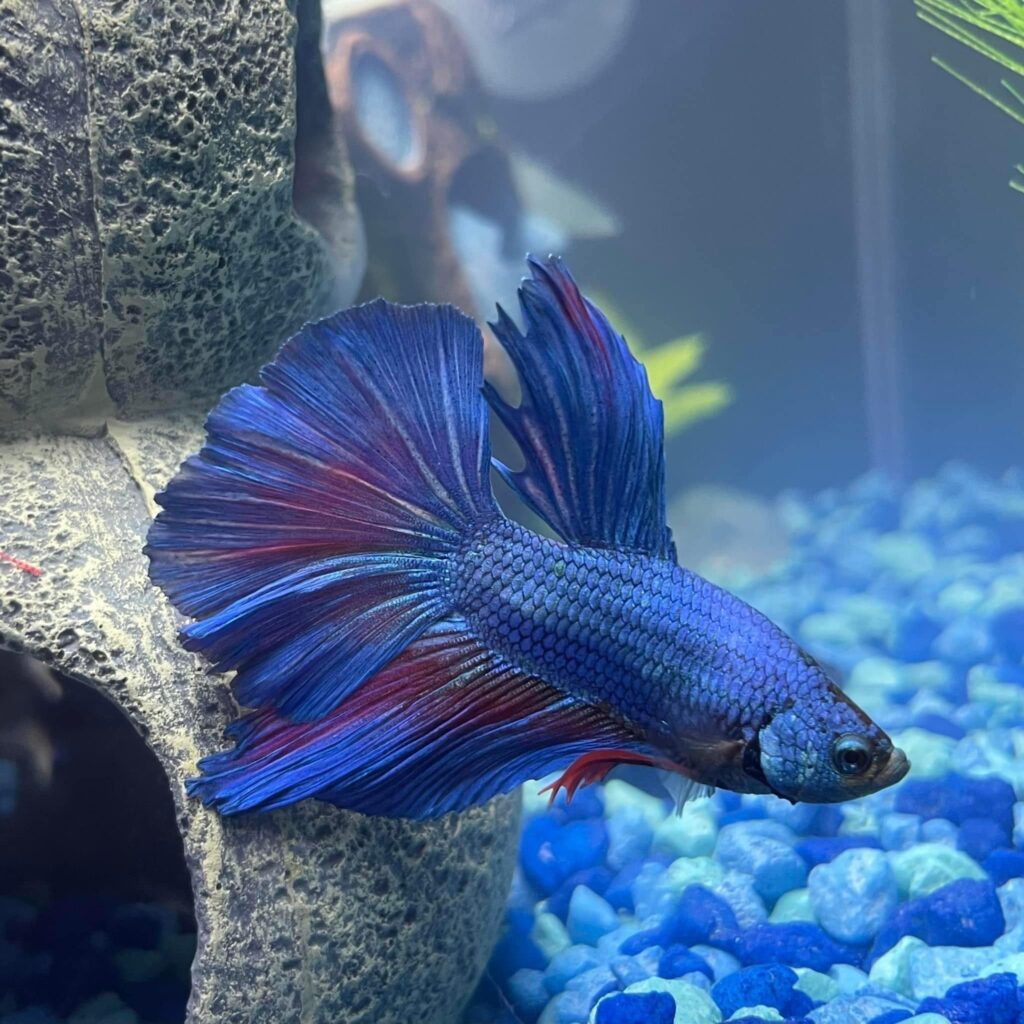
Delta Tail Bettas are named after the lowercase Greek letter delta (δ), which is a curling symbol that looks like a swooping line. This is because the Delta Tail Betta’s tail resembles this symbol, turned 90 degrees.
Delta Tails have large dorsal and anal fins, but they lack the full 180-degree spread that can be seen in Half Moon Bettas. Instead, the dorsal and anal fins taper away from the body towards the tail.
Furthermore, Delta Tails have symmetrical tails, meaning that if you drew a line through the fish from the mouth to the tip of the caudal fin, you would find an equal amount of tail above and below the line.
3. Double Tail (DTD)
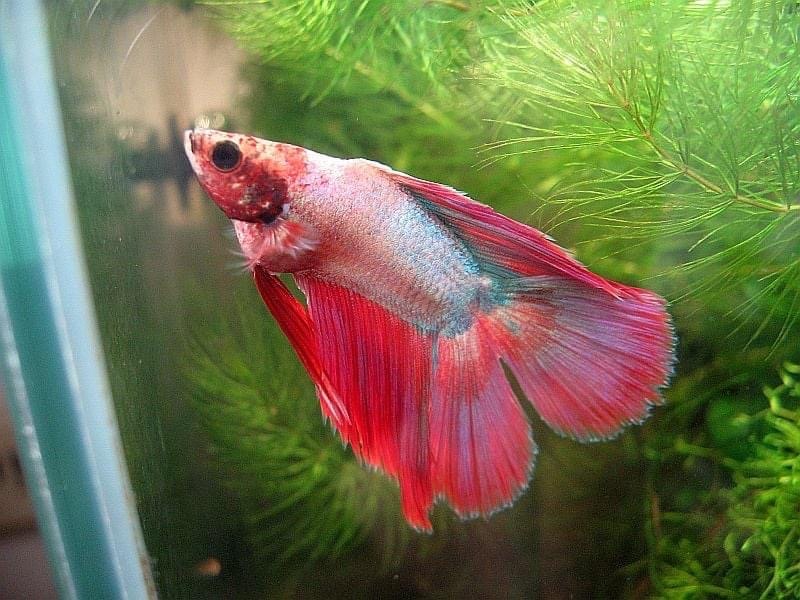
Double Tail Bettas, also known as DTDs, are recognized for their split caudal fin that creates the impression of a double tail at the back of the fish’s body. Their tails consist of two rounded lobes, complemented by large dorsal and anal fins.
DTDs typically have shorter bodies and are particularly susceptible to Swim Bladder Disease (SBD), which is unfortunate for this breed. Additionally, their fry survival rates are comparatively lower than those of other Betta breeds.
Double Tails can have varied ancestry, and their aggressiveness can differ accordingly. While some DTDs are known for their mild temperament, others can be quite feisty.
4. Half-Moon Tail (HM)
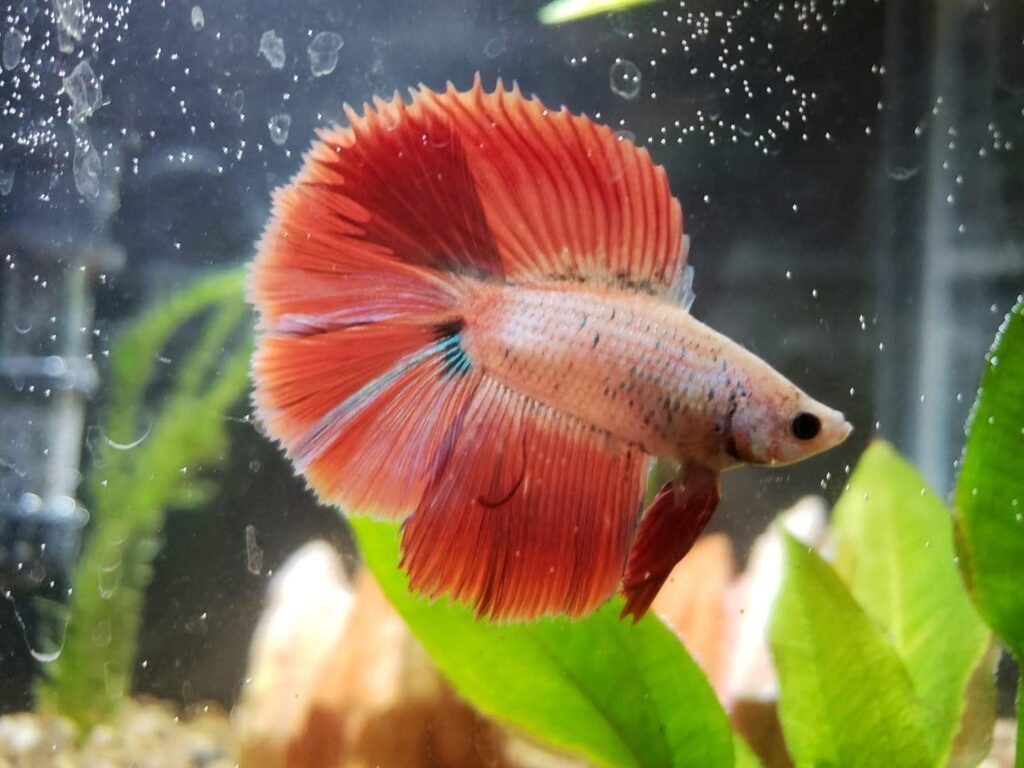
Half-Moon Tails, also known as HM Bettas, are a highly coveted breed due to their impressive and proud caudal tail, which spans a full 180 degrees and ends in a straight line at the body. The shape of their tail creates the perfect capital D.
In addition to their unique tail shape, HM Bettas also possess exaggeratedly large anal and dorsal fins, which adds to their overall allure and popularity.
However, breeding Half-Moon Tail Bettas can be a challenging task due to their overlarge tails, making it difficult for the male Betta to wrap the female Betta during mating. Furthermore, the large tails can also lead to tail-biting behavior and increase the likelihood of fin damage.
5. Crowntail (CT)

Crowntails are a distinct breed that can be recognized easily even by the untrained eye. They are identified by their webbed fin rays that grow into long and distinct prongs, with a single prong referred to as a ray. The fins of Crowntails can split several times, resulting in double, triple, and even quadruple rays. Breeders typically charge more for double and quadruple-ray Crowntails.
The most sought-after Crowntails are those with a full 180-degree spread of their tail, although less is also acceptable. However, it’s essential to note that this breed is highly aggressive.
6. Combtail (COM)
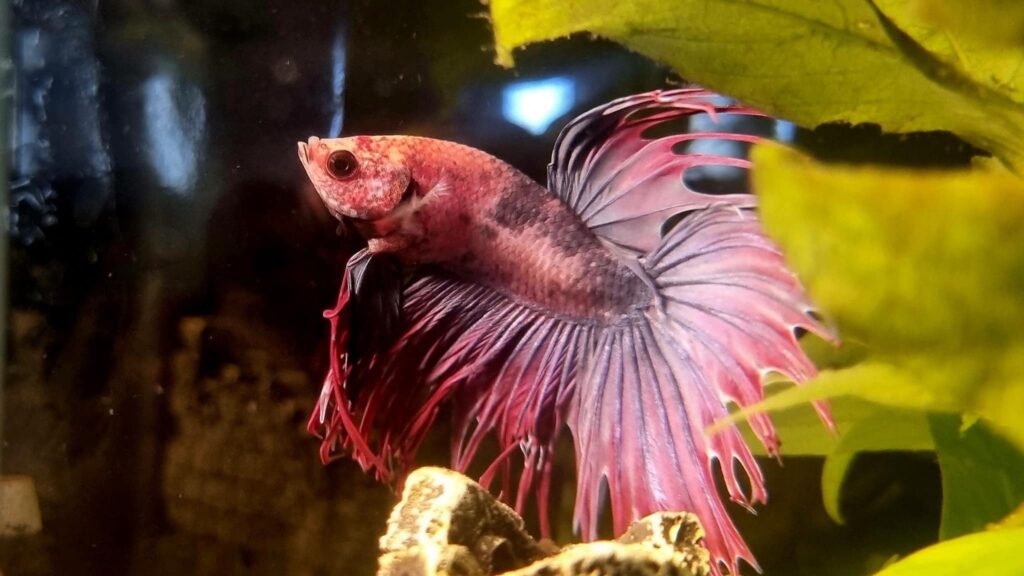
Combtail (COM) Bettas are recognized for their unique and distinct appearance, which resembles the teeth of a comb across their fins and tails. Their rays extend beyond the webbing of the tail, creating a dramatic and spiky appearance. Ideally, the caudal fin should extend significantly, although not beyond 180 degrees.
While some Combtails may feature a droopy tail, similar to Veiltails, this trait is deemed less desirable by Betta breeders and enthusiasts.
7. Round Tail (RT)
Round tails are recognized for their single, large, and rounded lobe that gives them their name. They can be distinguished from Delta Tails by the absence of any straight lines where the tail meets the body. Although they are similar to Plakats, their tails are substantially larger.
8. Spadetail (ST)

Spadetail Bettas have a similar appearance to Round Tail Bettas, but their caudal fin ends in a point instead of a rounded lobe. The shape of their tail is reminiscent of a squashed spade symbol found in a deck of cards.
Unlike some other breeds, Spadetails have symmetrical caudal fins, with an equal amount of fin above and below a line drawn between their mouth and the point of their caudal fin.
Spadetails are generally known for being calmer fish, similar to Veiltails. Despite being a popular breed in the 1990s, they have become increasingly rare.
9. Rosetail
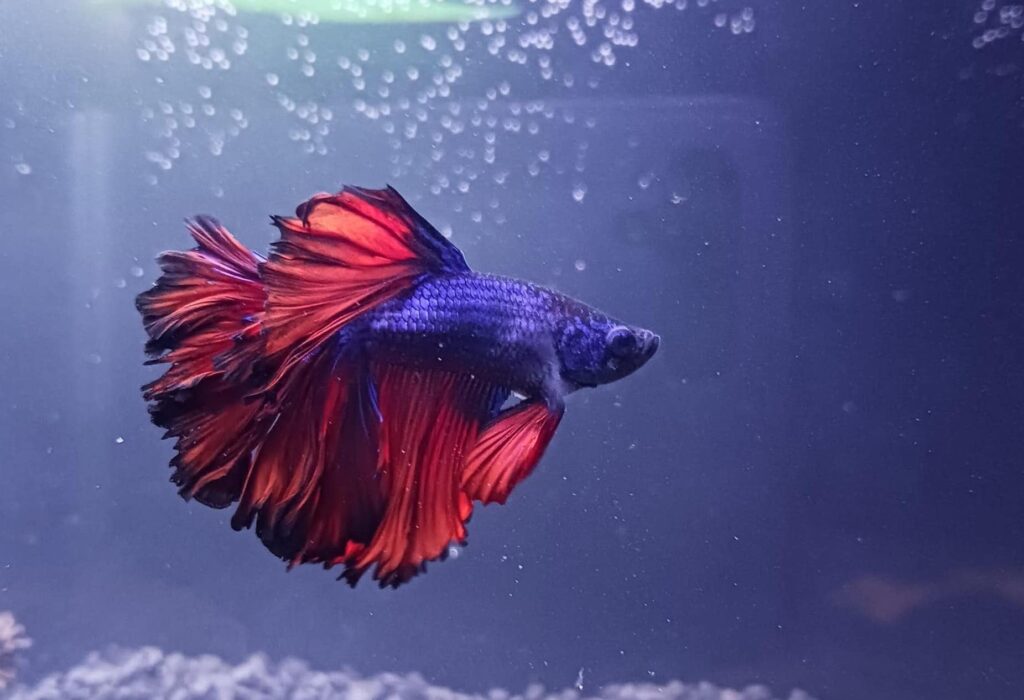
Rosetail Bettas are a highly specialized form of Half Moon Bettas, and as such, their caudal fin should fan out to 180 degrees or more.
What sets Rosetail Bettas apart from HMs is the appearance of their fins and tail. The rays at the end of their fins and tail are ruffled and branched, creating a feathered look. In fact, with enough branching, Rosetails are often referred to as Feathertails.
However, breeding Rosetail Bettas is challenging. The genes responsible for branching in the tail can also lead to undesired mutations, such as shorter pelvic fins and bad scales. These mutations result in poor swimming ability and a lower quality of life, despite their extravagant beauty. Rosetail Bettas can often catch their ruffled fins on plants and decorations, so it is crucial to ensure that there are no sharp objects in the tank to prevent injury.
10. Fantail
Fantails are one of the rarest breeds of Betta fish. Unlike other types of Bettas, Fantails have not one but two caudal fins that are fused close to the top, giving them the appearance of a fantail goldfish.
Betta Fish Types Based on Color and Pattern
Bettas come in a stunning array of colors, ranging from delicate pastels to shining iridescent purples and coppers. They can be a solid block of color or have multiple colors, and some have different hues on their fins and tails. Let’s explore the various types:
Solid Color
First, the solid colors.
11. Red Betta
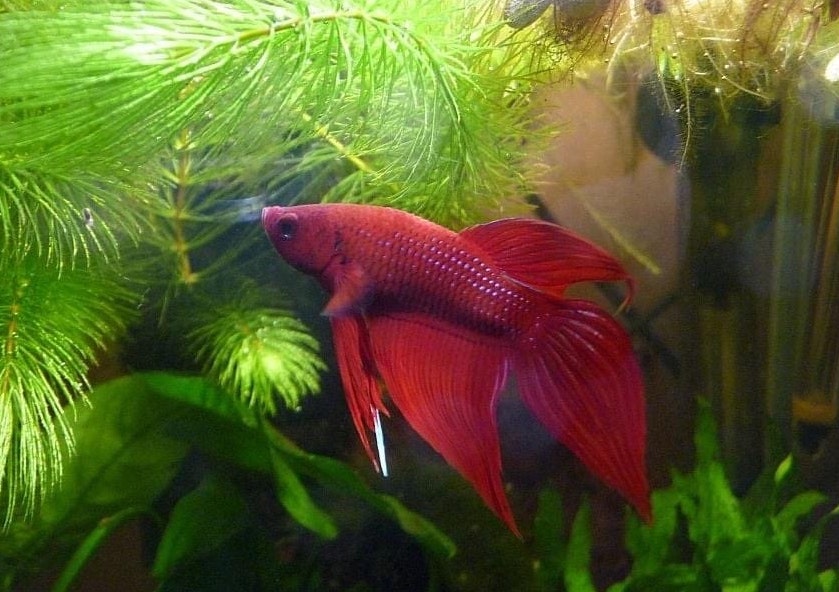
Red is a very common color among Betta fish, and you can find many tail and fin types in the color red, from Half Moon to Plakat.
Most red Bettas are a solid color, bright red from mouth to tail, but occasionally, you may find red showing through against a paler pigment. This is called “red wash,” and while these red-wash Bettas are similar to Marble Bettas, they are considered undesirable.
12. Blue
Blue Bettas are found in several shades: Steel Blue, Royal Blue, Turquoise Blue Wash, and a rarer Baby Blue.
Steel Blue Bettas have a colder color tinged with gray, while Royal Blue Bettas are truly iridescent. Whatever the shade, blue Bettas often have faces darker than the rest of their bodies, ranging from navy blue to black.
13. Green
Bettas that truly look green to the naked eye are rare, and these Green Bettas are uncommon and highly prized. Sometimes, darker Bettas will appear iridescent green under direct light.
When Bettas appear naturally green, they are more commonly turquoise, while blue tinged with green is classified as a Blue Betta.
14. Black
Black Betta Fish come in three types: Melano, Black Lace, and Metallic.
The darkest black Bettas are Melano. The gene that increases the black pigment in these Bettas also makes them infertile, so Melano Bettas can only be bred by females of other colors who carry the Melano gene. This makes them rare and, inevitably, more popular among fish keepers.
Black Lace Bettas are fertile and more easily bred. They’re more common but less desirable, and their pigment is less dark than Melanos.
Metallic Black Bettas aren’t fully black and often have other colors across their scales. Their black scales are iridescent, giving them a metallic sheen.
15. White
White Bettas can vary. Some have dull scales, while others are more metallic and become iridescent in the light.
White Bettas are rare but can be obtained from specialist breeders. Some White Bettas may turn blue later in life as pigment develops, while metallic white Bettas will never change color. Sadly, the gene that gives these thick, metallic scales also causes health problems.
16. Albino
Truly White Bettas, lacking any pigment across their scales, are albino. They are exceptionally rare.
Like albino creatures from other species, albino Bettas have red or pink eyes. If you have a white Betta with black eyes, it’s not albino. If it lacks pigment but has black eyes, it’s a clear Betta.
Sadly, Albino Bettas have a lot of health problems and are prone to blindness. While they are beautiful, they are rare and hard to breed.
17. Yellow
Yellow Bettas can vary in shade from pale yellow to deep and rich yellow, resembling the color of butter. Darker, “dirty”-looking yellow shades are known as Pineapple Yellow.
Yellow Bettas typically possess a red-loss gene that eliminates the undesired red-wash appearance.
18. Orange
Orange, the classic color of a goldfish, is actually rare and highly prized in Bettas.
In poor lighting, orange Bettas may not display their tangerine glow and can appear red instead. Take a closer look at the pet store to determine if a plain Red Betta is actually a highly sought-after Orange in disguise.
19. Purple/Lavender
Purple Bettas are found in two shades: a darker violet and a pale lavender.
Both shades are quite rare. They can possess iridescent bodies and often have fins and tails in red, pink, or various shades of purple.
20. Clear/Cellophane
Clear Bettas have translucent skin without any pigmentation. Their transparent skin resembles cellophane and, except for the fish’s pink innards, they would be entirely see-through. Nonetheless, they are tinged pink.
Cellophane Bettas are often mistaken for Albinos, but true albinos are much rarer and have pink eyes rather than black.
Multi-Color
Many Bettas showcase more than one color across their body. These multicolored and beautifully patterned Bettas are delightful to behold.
21. Marble
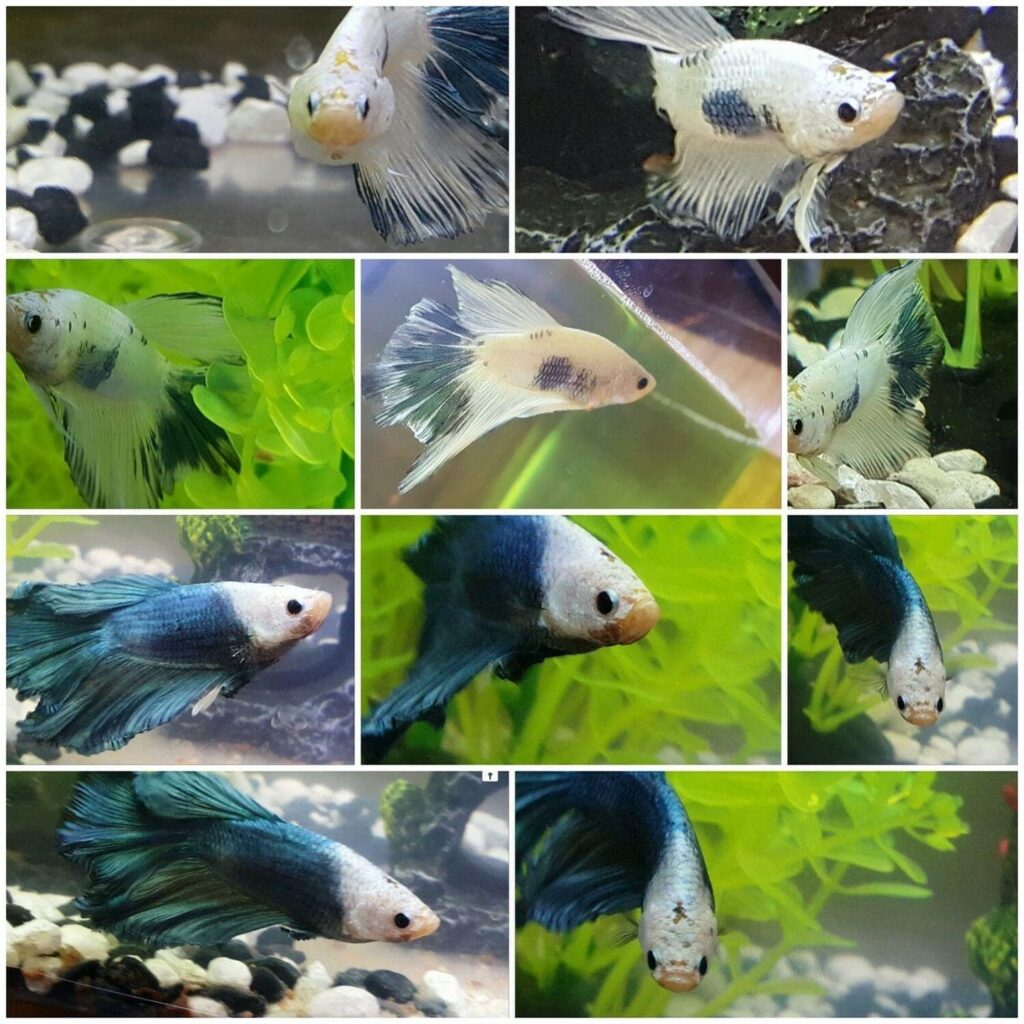
Marble Bettas feature two or more colors across their bodies arranged in an irregular, blotchy pattern. They are commonly blue or red, sitting atop a pink or opaque base.
For a Betta to be classified as Marble, the blotchy pattern must extend across the body, but the fins may have either a solid color or be translucent. These Bettas are increasingly prevalent, and their patterns may transform throughout their lifetime.
22. Dragon Scales
Dragon Bettas have iridescent or metallic scales overlaying a vibrant base color, typically blue or red. They are highly impressive and increasingly popular.
At times, Metallic Bettas are confused with Dragon Bettas, but for a Betta to be a true Dragon, it must have thick scaling encompassing the body and diverse fins. These thick scales, resembling those of a dragon, are as much a hallmark of this fish as its color.
23. Butterfly

Butterfly Bettas exhibit a solitary body color that stretches into the base of their dorsal and anal fins, as well as their tail. This color stops at a single line across their fins and tail, with the remaining portion being a lighter variation of the initial color or translucent.
The division may occur anywhere along the fins. A half-and-half color division is the most desirable for this breed, but as long as the color is separated 80/20 in either direction, then this pattern can be regarded as Butterfly.
24. Chocolate
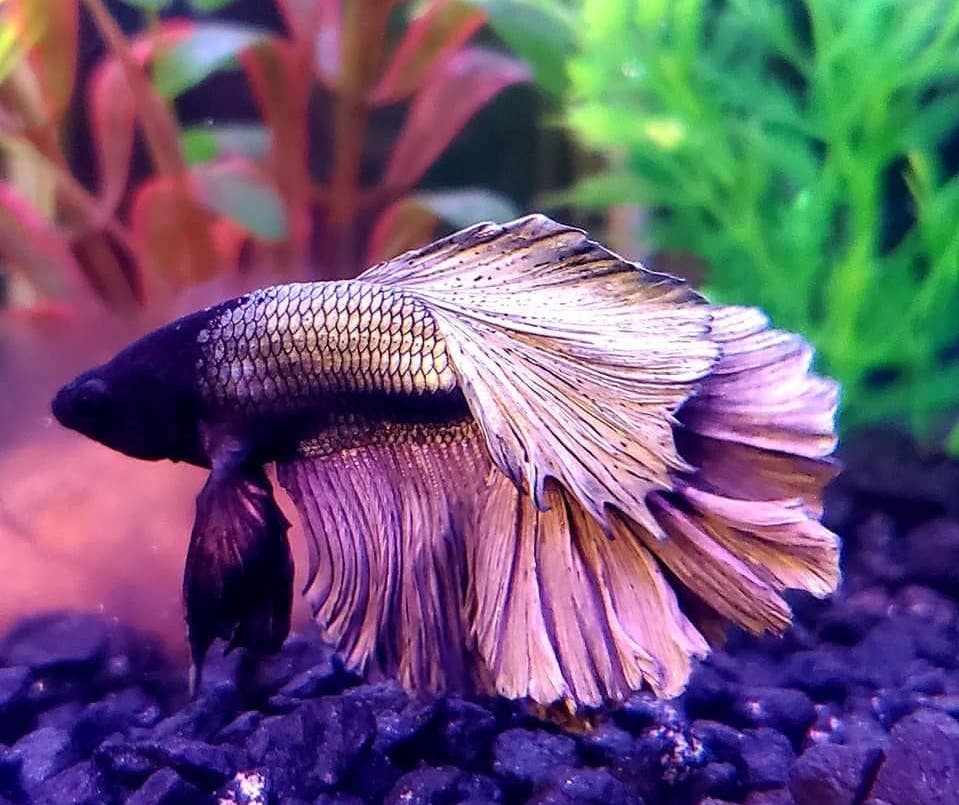
Chocolate Bettas have rich brown-colored bodies and lighter fins and tails, typically golden yellow. Occasionally, the bodies of Chocolate Bettas can exhibit an orangey tint, although the most desirable ones are of a pure, deep brown hue.
Due to their yellow or golden fins, Chocolate Bettas can be confused with Mustard Gas Bettas. However, the key distinguishing feature is that the body of a Chocolate Betta should be brown, rather than dark blue or green.
25. Mustard Gas

Mustard Gas Bettas are bi-colored with golden fins, similar to Chocolate Bettas. However, instead of possessing richly brown “chocolate” bodies, they have dark green or blue bodies.
Mustard Gas Bettas are quite rare. Occasionally, the color of the body will extend into the fins and tail, but it shouldn’t go too far.
26. Koi

Koi Bettas are a rare variation of Marbled Bettas that are created through deliberate breeding. As the name suggests, they are bred to resemble Koi carp with their multicolored orange, black, and pale marbling.
It’s unlikely that you will find Koi Bettas in a pet store. This unique breed is usually only available from selected breeders.
27. Panda
Panda Bettas have dark scales, usually black or inky blue, overlaid over a pale pigment. This gives them the characteristic Panda look, although the dark pigment doesn’t have to be restricted to the area around their eyes and can be banded on the body.
You can find Panda Bettas with a range of tail types, including Half Moon and Plakat.
Iridescent
Iridescent Bettas have shiny scales, although in poor lighting, they can sometimes appear dull.
28. Mettalic
Metallic Bettas have iridescent scales in black, copper-brown, violet, or white. In poor lighting, they can often appear dull, simply brown or black, but under strong light, they shimmer and shine.
Metallic Bettas can sometimes be mistaken for Dragon Bettas, but they have smaller, thinner scales.
29. Galaxy

Galaxy Bettas are a relatively new and rare breed of Betta fish that are highly sought after for their unique appearance. They are a subvariant of Koi Bettas, which means they have a three-way marbling of orange, black, and white on their bodies, giving them a distinctive look.
What sets Galaxy Bettas apart from Koi Bettas is the addition of iridescent scales that create a galaxy-like pattern of spots across their bodies. These spots can be various colors, including blue, green, purple, and even pink, and add an otherworldly shimmer to the fish’s appearance.
30. Opaque
Opaque Bettas have a gene that lays a milky white pigment over another color in their scales, so they sometimes appear as a pale pastel color in different lighting conditions. There are Opaque versions of all the common solid colors, with red and blue being the most commonly seen colors.
Betta Fish Types Based on Fin Type
The anal and dorsal fins, which are located on the top and bottom of the fish and provide stability during swimming, can also be used to classify Betta fish.
31. Plakat
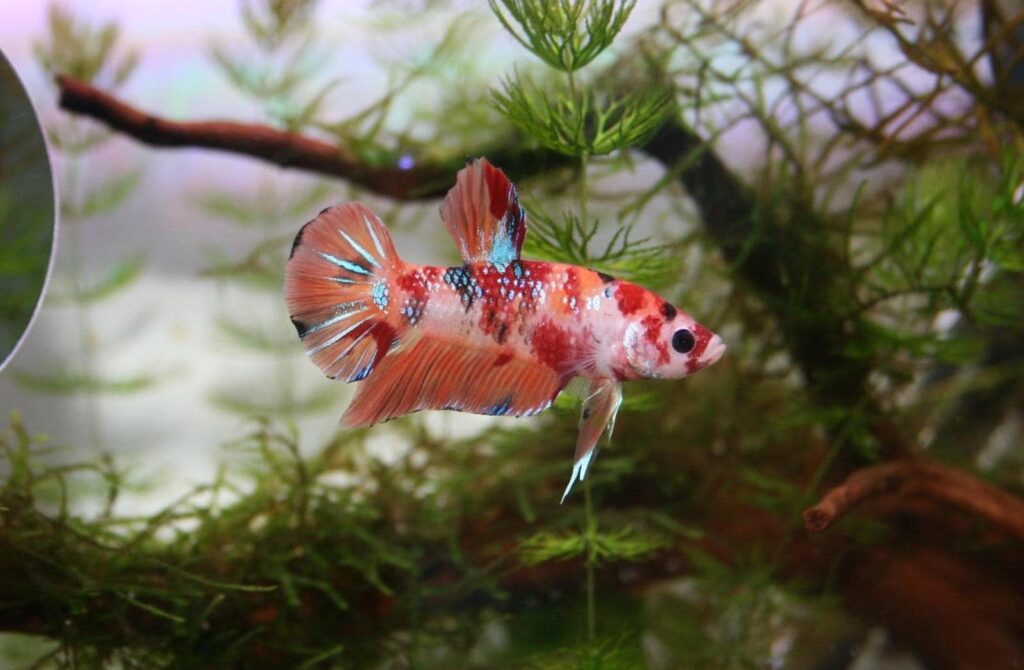
Plakat Bettas are very common and still resemble the Betta fish found in the wild. They have short tails and smaller anal and dorsal fins, but Half-Moon and Crowntail varieties are being bred with more impressive fins and tails. You can find them in a range of colors, and they usually have multiple pigments across their scales.
Male Plakats have longer ventral fins, which are the fins on the sides of their bodies, and more rounded tails than female Plakats.
Plakats are particularly feisty and aggressive Bettas – their name comes from the Thai word for fighting fish.
32. Short Fin (SF)
Short Fin refers to Plakats and certain breeds of Koi Bettas without extravagant extended fins like those seen on Rosetails, Deltas, and other types of Betta fish.
33. Half-Moon Plakat (HMPK)

Half-Moon Plakats are Plakat Bettas that have been selectively bred to have extended, 180-degree caudal tails. While Plakats resemble wild Bettas, HMPK Bettas are showier, but they maintain the feisty temperament of traditional Plakats.
Other Betta Fish Types
34. Alien Betta
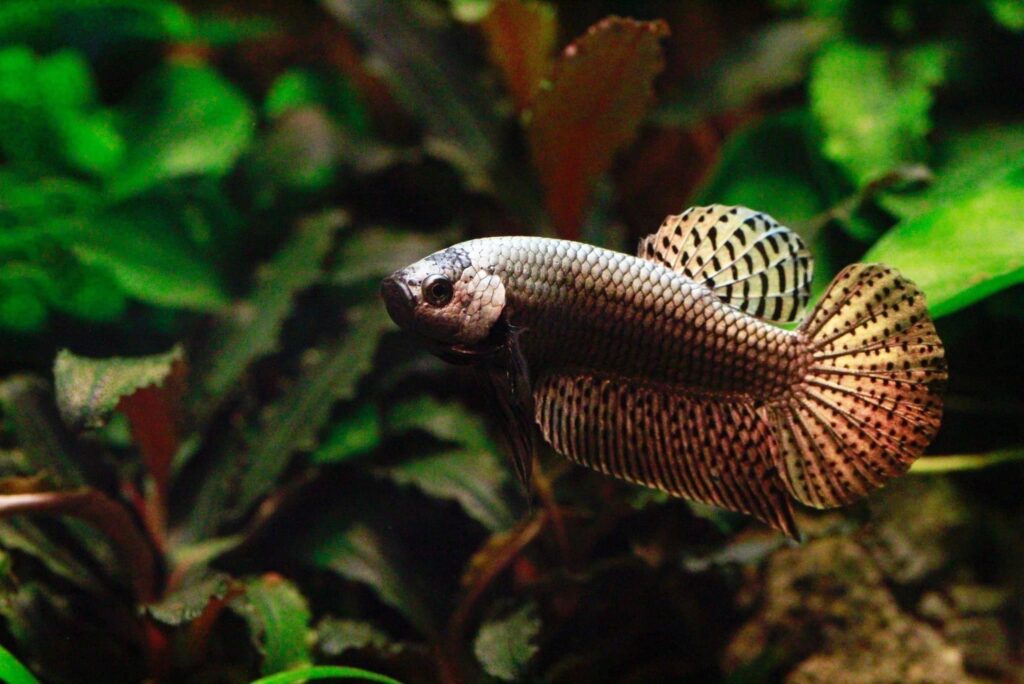
Alien Bettas are born from the hybridization of different Betta species. They look like Metallic Bettas but have uniquely patterned scales and webbed caudal fins.
Alien Bettas have a base color of electric blue, purple, or teal. They’re a rare breed, but always beautiful and vibrant. They are also very aggressive and males are best kept alone.
35. Wild Type (WT)
Wild Type Bettas resemble the appearance of Bettas in the wild before selective breeding popularized rare colors and extravagant fins and tails. They have smaller fins and tails compared to other breeds and are usually predominantly red or brown across their bodies with red fins. Occasionally, they can be found with iridescent scales.
36. Super Delta (SD)
Super Deltas are similar to Deltas, except that their tails extend almost 180 degrees when flared. They’re considered to be in between Deltas, with smaller tails, and Half Moons with their full 180-degree tail.
Super Deltas should be symmetrical, with an equal amount of tail above and below a middle line. This feature can be used to distinguish them from Veiltails.
37. Elephant Ear (EE)

Elephant Ears, also known as Dumbos, have enlarged pectoral fins. This is a relatively new breed, and for now, only male Elephant Ears have been bred with pectoral fins larger than their heads. However, through selective breeding, these fins will soon compete with the extravagant anal and dorsal fins found on other breeds.
Given the trend for enlarged fins across all breeds, we can expect to see Dumbos being crossed with Half Moons and Super Deltas soon.
38. Over Half-Moon (OHM)
Over Half Moons (OHMs) have exceptionally large caudal tails that extend beyond 180 degrees when flared. They can be created by breeding both long-fin Half Moons and Half Moon Plakats (HMPKs), resulting in OHMs with either long or short fins.
39. Giant Betta
Giant Bettas grow larger than any other breed of Betta fish, reaching up to almost twice the size of other breeds. While they can grow up to 8 inches in length, most won’t exceed 5 inches.
They usually display solid colors, such as red, green, or blue, and have large, attractive fins.
Despite their size, these fish are gentle giants and are one of the more peaceful species of Betta fish.
40. King Betta
King Bettas are generally white or bright beige, and despite their name, they don’t grow any larger than other Betta species. As with other species, males are larger and more colorful than females.
The origin of King Bettas is unknown, but it’s possible that they resulted from interbreeding in the wild between Betta raja and Betta splendens. They are very aggressive and make poor tankmates for other species.
Betta Fish Type FAQs
Any questions? Cast the rod and you’ll catch the answer here.
What’s the calmest Betta breed?
The calmest Betta breed is the Betta Imbellis, which is often referred to as the “peaceful Betta” due to their docile and non-aggressive nature. They are known to get along well with other fish in the tank.
If you’re specifically looking for the Betta splendens species (also known as the fighting fish), the calmer breeds are Veiltails (VT), Crowntails (CT), and Giant Bettas.
What’s the most aggressive Betta breed?
The most aggressive breed of Betta is the Plakat. These Bettas have smaller fins and tails, which make them agile swimmers in the water. Due to their breeding history, they have been developed to be more aggressive than other Betta breeds. Plakats are known to be so feisty that they have been observed jumping out of their tanks.
What’s the rarest Betta breed?
Fantails are the rarest breed of Betta, and there’s very little information available about this type. In terms of color, Albino Bettas and pure black Bettas are also rare.
If you happen to come across an albino fantail Betta, please let us know!
What’s the easiest type of Betta fish to keep?
Veiltails are the easiest Betta fish to keep and a great choice for beginners. They have a more peaceful temperament and are easy to care for, as they can tolerate a wider range of conditions. Additionally, they are a common breed and can be found in most pet shops. Therefore, if you’re new to keeping Bettas, Veiltails are a great place to start.
Wrapping Up
The splendid array of Betta splendens can even confuse experienced hobbyists. It can be difficult to discern the fine line between a Delta and a Super Delta, or to differentiate between Metallic and Dragon based on the subtleties of scale size. Furthermore, active breeders are constantly crossing different types, leading to the emergence of new Bettas all the time, making it hard to keep up.
If you’re new to fishkeeping, don’t worry about finding the rarest Betta fish. Veiltail Bettas may not be prized on the show circuit, but they’re easygoing Betta fish with beautiful tails and flowing fins. After all, the health of the fish in your aquarium is the most important thing to consider.